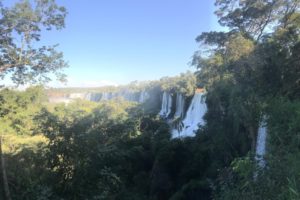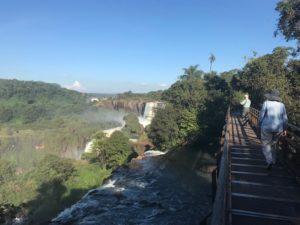Having danced tango, Buenos Aires was a magical place in my imagination for years. Luckily, the city met all expectations and then some. During our city preview, the local team mentioned that when trying to come up with the “must see” (read: tourist) attractions, it became apparent to them that the attraction of Buenos Aires is living there.
We lived in the Palermo district – should I visit again, I would try to find a place away from busy streets, as the Argentines like their car horns more than New Yorkers.
Tigre
The first weekend I escaped the city jungle right away, like the locals do. About an hour train ride away is “El Delta” (Tigre), where many from the city have a house or even live and commute to work. The houses tend to be built piece by piece as money comes together from family and friends – who then come by every weekend! We were lucky to find Tigre Safaridelta, owned by Fernando (Fer), who takes you out on a motorized inflatable boat (max 4 people) to the places that bigger tour boats can’t reach. We spent 5 hours, sometimes in pouring rain, going up and down the waterways, having the best steak I have ever had in my life and watching the wild life. There are no roads – everything is reached by boat along the waterways. Although it was rainy and overcast, it was still wonderful to get out in the fresh air, away from the noise and bustle of the city. Fer moved to Tigre after losing everything in the financial crisis at the turn of the century and started this company. A street dog that adopted his family became the mascot he needed to get his company off the ground.




Isla Maciel, La Boca
One of the most iconic images of Buenos Aires are the colorful houses of La Boca. They are so colorful because people paint their corrugated iron houses with the leftover paint from the ships and don’t always have enough of one color. The area is where most immigrants ended up living when first coming to BA. Isla Maciel is a tough, isolated neighborhood across from La Boca that the locals are trying to change. One project is called
Pintó la Isla, which invites artists to paint murals around the neighborhood.







La Boca is where tango was born. During the 1800s, Argentina advertised in Europe that if Europeans came, they would be given land here. Once they arrived, they were not given land and they all huddled in La Boca, working in the port. There were about 9 men for every woman. The men would stand in long lines outside the prostitutes’ doors and in order to get to the head of the line, would “fight” by grasping the elbows of the man in front and trying to step on each other’s feet. Since there were many people speaking many languages, the easiest way to communicate was through music and dance and tango was born.
Throughout the streets were images of head kerchiefs in a circle. These are the kerchiefs, which symbolize cloth diapers, the
Mothers of the Disappeared wore in protest of the last Argentine military dictatorship that “disappeared” their children. Protesting was illegal and groups of more than 2 in public was illegal, so the mothers walked in silent groups of two in a circle at the Plaza de Mayo. 500 of the disappeared were pregnant women, who were kept alive until they gave birth, their children were given away and then the mothers were killed. DNA testing is now being used to unite these children with their grandmothers. The protest continues to this day, as the motto is never forget, never forgive.



On a bike tour of the city with Biking Buenos Aires (which was very very good), we came to Catedral Metropolitana where San Martin, the liberator of Argentina, Chile and Peru is buried. One of the emblems had red paint on it. While we were there, women in Buenos Aires were wearing green scarves in support of legalizing abortion. The red paint was part of the protest, symbolizing the blood of women, disproportionately poor ones, who died from complications of illegal abortions. The church decided to leave the red paint, as it is a sign of protest and if removed, would probably lead to worse defacing. The guide also mentioned that because of social reforms such as divorce and legalizing abortion, the church was on the side of the military after the Peron rule, which led to decades of brutal suppression and murder of the people.
Iguazu Falls
On the boarder between Argentina and Brazil lie the
Iguaza Falls, one of the 7 natural wonders of the world. It is breathtaking. Only 7% of the original forest still exists. The water of the falls used to be clear, but with the clearing of the forest, it now runs brown with the run off.
We also visited Parque das Aves (bird park) on the Brazilian side. The park rehabilitates birds and tries to re-introduce them into the wild. There are several bird species there that are extinct in the wild and they are hoping to bring them back into the ecosystem. Even plants are helped in the park – one area was full of plants that had endured a forest fire.























